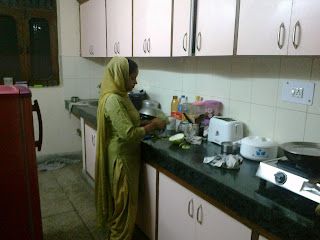Sarah Lacy is the Silicon Valley based author of "Brilliant, Crazy, Cocky: How the top 1% of entrepreneurs profit from global chaos."
I came across her book while visiting my company Indiangenie's webpage on Just Dial website. (India's local search engine, but it is more of a sophisticated yellow pages.) An article (India's mighty microeconomy) by Sarah Lacy on the Fast Company magazine appealed to me and i was almost about to buy her book on Flipkart.
Her travel across several countries in order to grasp what entrepreneurship is about is commendable and i would subscribe to most of her findings and terminologies. The article 'India's mighty microeconomy' is also a very good assessment of what is going on beneath the famed Indian macroeconomy.
I, however, would disagree to what she says on her own webpage on India.
" I do try to make sense of the clear disconnect between people saying things have gotten better, who also complain bitterly about India's problems. And this isn't subjective. I cite hard statistics that show the quality of life across most metrics in India is improving at just 1% per year, while more than 2/3 of the country lives in villages with no access to basic roads, water or electricity and less than 1 million people-- out of $1.1 billion-- benefit from high paid R&D and call center jobs.
I came across her book while visiting my company Indiangenie's webpage on Just Dial website. (India's local search engine, but it is more of a sophisticated yellow pages.) An article (India's mighty microeconomy) by Sarah Lacy on the Fast Company magazine appealed to me and i was almost about to buy her book on Flipkart.
Her travel across several countries in order to grasp what entrepreneurship is about is commendable and i would subscribe to most of her findings and terminologies. The article 'India's mighty microeconomy' is also a very good assessment of what is going on beneath the famed Indian macroeconomy.
I, however, would disagree to what she says on her own webpage on India.
" I do try to make sense of the clear disconnect between people saying things have gotten better, who also complain bitterly about India's problems. And this isn't subjective. I cite hard statistics that show the quality of life across most metrics in India is improving at just 1% per year, while more than 2/3 of the country lives in villages with no access to basic roads, water or electricity and less than 1 million people-- out of $1.1 billion-- benefit from high paid R&D and call center jobs.
Those are just facts, Vivek, I didn't make them up. And Indians and India's American boosters have to face them if India is going to unlock the economic potential of its huge population. Just talking up the good of India would have been highly dishonest as a reporter and wouldn't help the entrepreneurs trying to create real change in the country."
Sarah you can be assured i do not know who Vivek is and i am not trying to defend him. I am also not a fanatic nationalist who would just want to hear good things about his country. The problem, however, with the above understanding is that it is incomplete and not accomodative of the historical background. As you rightly mention, what you have are 'mere facts.'
A growth of 1% per annum is also an achievement given that this was not possible a few years back. The number of people with water or electricity is increasing each day even when its true that the absolute numbers of the ones deprived are high. I belong to a small town in Ara and even though my house is connected to the grid we depend on solar electricity. I am aware that it's a million or two fortunate people to find high paying jobs but one cannot ignore hordes of people that get employed in trying to service these 1-2 million people in their houses and in their offices. The trickle down is significant and you can see the flow even if you pick the life of one of these office going guys. Beyond the offices, the avenues to make money in agriculture, and as you very well know 'in the mighty microeconomy' are huge.
Harping about the level of deprivation then is no news and no novelty. It has been there for long and is not expected to vanish in a minute. The news is that there is hope now. We can hope that ten year down things would have slightly ameliorated compared to the four decade long lull.

